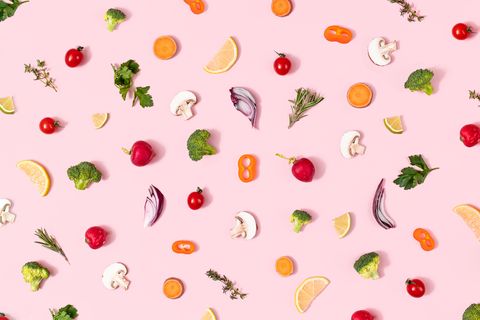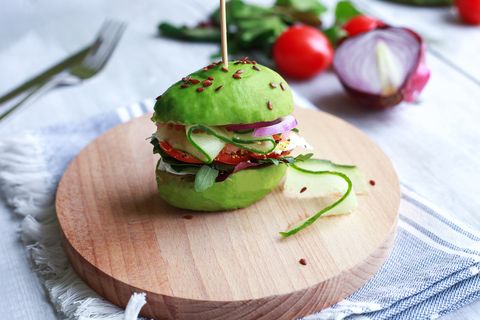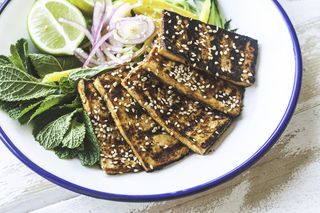Whole30 is an eating plan that follows a paleo philosophy with a few extra restrictions. It is not a diet, per se, in that there are no calorie restrictions nor tracking of your intake, and it’s not intended for weight loss. Instead, it’s akin to an elimination diet plan. Whole30 emphasizes consuming whole foods while eliminating sugar, alcohol, grains, legumes and dairy for 30 days. The program discourages weighing yourself or taking other measurements during that period, so that the focus is on non-scale victories and not weight loss, according to Melissa Urban, cofounder and CEO of Whole30.
Since 2009, this has been a popular eating plan, and it has had a strong following among people hoping for a nutritional reset. It has not been without controversy, however, with several criticisms surrounding the removal of entire food groups, such as whole grains, legumes and dairy, as well as the severe restrictions in what you cannot eat, such as pizza. At a time when many voices argue that “all foods fit,” Whole30 is adamant that, at least for 30 days, not all foods should fit.
The program was created by Urban and Dallas Hartwig, certified sports nutritionists and New York Times bestselling authors. The diet started in part as an experiment by Urban, who was hoping she could change her relationship with food. It was designed as an elimination plan to find out how certain foods can affect things like energy levels, aches and pains, digestive issues and allergies. Although this program is not intended to treat or diagnose any diseases, according to research studies, elimination diets can be an effective tool to help some patients with various gastrointestinal conditions.
What is the Whole30 plan?
Whole30 is an eating plan that begins by eliminating certain foods for 30 days. At the end of those 30 days, you reintroduce the eliminated foods over a 10-day period, one food group at a time, and watch for any changes that can help you navigate your diet as it relates to your overall health. For example, some people discover improved energy levels and better sleep when not consuming certain foods, while others might see a reduction in gas or bloating.
“The program and our voice have evolved quite a bit since the earliest days,” says Urban. “We focus far more on accessibility and representation now, ensuring everyone who wants to be a part of our community feels heard and valued and sees themselves in our work.”
What foods can you eat on Whole30?
- Meat: unprocessed meat including beef, chicken, turkey, pork
- Seafood: all seafood including fish, shrimp, mussels, lobster, oysters
- Vegetables: including potatoes, green peas, green beans
- Fruits: all fruits including watermelon, bananas, grapes, berries and 100% fruit juices
- Nut butter, nuts and seeds
- Fats: olive oil, coconut, avocado oils, clarified butter and ghee
- Vinegars and botanical extracts, with the exception of malt vinegars that contain gluten
- Coconut aminos, which can be used as a replacement for soy sauce
- Iodized salt
- Herbs and spices
- Black coffee
What foods can you not eat on Whole30?
- Sugar: no white or brown sugar and no real or artificial sweeteners, including maple syrup, honey, agave nectar, coconut sugar, date syrup, monk fruit extract, stevia, Splenda, etc.
- Alcohol, including for cooking
- Gluten, including whole wheat pasta and breads
- Grains, including barley, oats, corn, quinoa, buckwheat, etc.
- Legumes: most legumes are off limits except for green beans and most peas (including sugar snap peas, greens peas, split peas, etc.)
- Dairy, including cow, goat and sheep’s milk
- Carrageenan and sulfites
- Treats, even those created with Whole30 ingredients
What is the new plant-based Whole30?
The original Whole30 program was designed for people who consume animal proteins. “While we’ve always had vegetarians and vegans in our community, we recognized a few years ago that we could be — and wanted to be — supportive of them even more than we already were,” said Urban. In February 2022, Whole30 launched its new plant-based plan.
While there is a lot of overlap between the two programs, the main difference is that the original Whole30 includes animal protein and fats and the plant-based Whole30 excludes all animal products; it incorporates only plant-based proteins and fats, including legumes, lentils and peas, whole or minimally processed forms of soy and whole forms of plant-based protein powders.
According to Stephanie Greunke, M.S., R.D.N. and co-creator of Plant-Based Whole30, a team of medical professionals including dietitians, nutritionists, functional medical doctors, nurses and a psychologist helped to create the new program. Their different perspectives helped shape the program to ensure nutrient-sufficiency and to support the identification of food sensitivities during reintroduction.
Sample Whole30 meal plans
The following is a snapshot of what three-days can look like on the original Whole30 and the plant-based version. Take note that the plant-based version recommends four meals instead of three because, according to Urban, eating “four meals a day (compared to three on the Original Whole30) helps to ensure adequate protein intake.” Urban also emphasizes the importance of specific supplements like vitamin B12 when following the plant-based version, given their lack of abundance in plant-based foods. If you’re not big on preparing your own meals, Whole30 has partnered with Daily Harvest to create a Plant-Based Whole30 Menu Plan, which is delivered to your home.
Original Whole30 sample menu
Day 1
- Breakfast: Scrambled eggs with spinach and sliced avocado
- Lunch: Turkey lettuce wraps
- Dinner: Sautéed shrimp over cauliflower rice veggie stir-fry
Day 2
- Breakfast: Chia pudding with berries and almond butter
- Lunch: Kale Caesar salad with chicken
- Dinner: Baked salmon with paleo pesto over spaghetti squash
Day 3
- Breakfast: Veggie and egg scramble
- Lunch: Chopped salad with avocado, veggies and grilled chicken
- Dinner: Turkey meatballs over zucchini noodles with tomato sauce
Plant-based Whole30 sample menu
Day 1
- Meal 1: Chia pudding with a scoop of plant-based protein powder
- Meal 2: Lentil Bolognese over zucchini or Palmini noodles
- Meal 3: Smoothie made with plant-based protein powder, unsweetened nut or coconut milk or water, chia seeds, berries and spinach
- Meal 4: Cauliflower rice stir-fry with tofu
Day 2
- Meal 1: Plant-based yogurt parfait with berries, nuts, seeds and plant-based protein powder
- Meal 2: Chopped salad with tempeh and avocado
- Meal 3: Daily Harvest tomato and zucchini minestrone soup
- Meal 4: Vegan chili
Day 3
- Meal 1: Sweet potato stack with tofu and avocado
- Meal 2: Chickpea lettuce wraps
- Meal 3: Chia pudding with fruit and plant-based protein powder
- Meal 4: Jackfruit curry with cauliflower rice
Tips for those who want to try Whole30
Urban says that planning and preparation are key for success. Trying to “wing it” will likely lead to struggling, she adds. If you’re interested in eliminating and reintroducing foods according to the Whole30 plan, these recommendations can help:
✔️ Establish a social support system before starting. This will help you stay the course.
✔️ Set expectations — for yourself and others — around social activities like dinners with friends or date nights.
✔️ Stock up on snacks that fit the Whole30 program (for example, nuts and fruits).
✔️ Keep it simple: Cook a protein, then add some veggies and healthy fats and tie it all together with a dressing or sauce.
The Bottom Line
Trying out Whole30 might be an interesting way to learn more about what works and doesn’t work in your personal diet. The nutrition pros in the Good Housekeeping Institute point out that this program is meant to be temporary and is not designed for weight loss. Eliminated foods can be reintroduced after the 30 days are over to help you determine which foods best support your health goals. Our experts note that there is still a lot of trial and error in the approach, and it is not indicated for everyone. It is especially not recommend for individuals who are pregnant or have a past history of eating disorders or disordered eating. Plus, each individual will likely have a unique experience on the program, so outcomes shouldn’t be generalized.
This content is created and maintained by a third party, and imported onto this page to help users provide their email addresses. You may be able to find more information about this and similar content at piano.io



